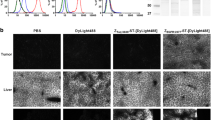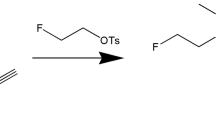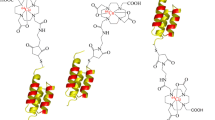Abstract
Positron emission tomography (PET) with epidermal growth factor receptor (EGFR) kinase-specific radiolabeled tracers could provide the means for noninvasive and repetitive imaging of heterogeneity of EGFR expression and signaling activity in tumors in individual patients before and during therapy with EGFR signaling inhibitors. We developed the synthesis and 124I-radiolabeling of the (E)-But-2-enedioic acid [4-(3-[124I]iodoanilino)-quinazolin-6-yl]-amide-(3-morpholin-4-yl-propyl)-amide (morpholino-[124I]-IPQA), which selectively, irreversibly, and covalently binds the adenosine-triphosphate-binding site to the activated (phosphorylated) EGFR kinase, but not to the inactive EGFR kinase. The latter was demonstrated using in silico modeling with crystal structures of the wild type and different gain-of-function mutants of EGFR kinases. Also, this was demonstrated by selective radiolabeling of the EGFR kinase domain with morpholino-[131I]-IPQA in A431 human epidermoid carcinoma cells and Western blot autoradiography. In vitro radiotracer accumulation and washout studies demonstrated a rapid accumulation and progressive retention postwashout of morpholino-[131I]-IPQA in A431 epidermoid carcinoma and in U87 human glioma cells genetically modified to express the EGFRvIII mutant receptor, but not in the wild-type U87MG glioma cells under serum-starved conditions. Using morpholino-[124I]-IPQA, we obtained noninvasive PET images of EGFR activity in A431 subcutaneous tumor xenografts, but not in subcutaneous tumor xenografts grown from K562 human chronic myeloid leukemia cells in immunocompromised rats and mice. Based on these observations, we suggest that PET imaging with morpholino-[124I]-IPQA should allow for identification of tumors with high EGFR kinase signaling activity, including brain tumors expressing EGFRvIII mutants and nonsmall-cell lung cancer expressing gain-of-function EGFR kinase mutants. Because of significant hepatobiliary clearance and intestinal reuptake of the morpholino-[124I]-IPQA, additional [124I]-IPQA derivatives with improved water solubility may be required to optimize the pharmacokinetics of this class of molecular imaging agents.





Similar content being viewed by others
Abbreviations
- PET:
-
positron emission tomography
- EGFR:
-
epidermal growth factor receptor
References
Arteaga CL (2001) The epidermal growth factor receptor: from mutant oncogene in nonhuman cancers to therapeutic target in human neoplasia. J Clin Oncol 19:32S–40S
Mendelsohn J (2002) Targeting the epidermal growth factor receptor for cancer therapy. J Clin Oncol 20:1S–13S
Grünwald V, Hidalgo M (2003) Developing inhibitors of the epidermal growth factor receptor for cancer therapy. J Natl Cancer Inst 95:851–867
Mendelson J, Baselga J (2003) Status of epidermal growth factor receptor antagonists in the biology and treatment of cancer. J Clin Oncol 21:2787–2799
Lynch TJ, Bell DW, Sordella R, et al. (2004) Activating mutations in the epidermal growth factor receptor underlying responsiveness of non-small-cell lung cancer to gefitinib. New Engl J Med 20: 2129–2139
Sordella R, Bell DW, Haber DA, et al. (2004) Gefitinib-sensitizing EGFR mutations in lung cancer activate anti-apoptotic pathways. Science 20:1163–1167
Pao W, Miller V, Zakowski M, et al. (2004) EGF receptor gene mutations are common in lung cancers from “never smokers” and are associated with sensitivity of tumors to gefitinib and erlotinib. Proc Natl Acad Sci USA 101:13306–13311
Huang SF, Liu HP, Li L, et al. (2005) High frequency of epidermal growth factor receptor mutations with complex patterns in non-small cell lung cancers related to gefitinib responsiveness in Taiwan. Clin Cancer Res 10:8195–8203
Rich JN, Reardon DA, Peery T, et al. (2004) Phase II trial of gefitinib in recurrent glioblastoma. J Clin Oncol 22:133–142
Learn CA, Hartzell TL, Wikstrand CJ, et al. (2004) Resistance to tyrosine kinase inhibition by mutant epidermal growth factor receptor variant III contributes to the neoplastic phenotype of glioblastoma multiforme. Clin Cancer Res 10:3216–3124
Fry DW, Bridges AJ, Denny WA, et al. (1998) Specific, irreversible inactivation of the epidermal growth factor receptor and erbB2, by a new class of tyrosine kinase inhibitor. Proc Natl Acad Sci USA 95:12022–12027
Balatoni J, Finn R, Blasberg R, Tjuvajev J, Larson S (1999) In: Duggan JL, Morgan IL (eds) Applications of Accelerators in Research and Industry. AIP Conference Proceedings 475, Part 2, pp 984–986
Sheh Y, Koziorowski J, Balatoni J, et al. (2000) Low energy cyclotron production and chemical separation of “no carrier added” iodine-124 from a reusable, enriched tellurium-124 dioxide/aluminum oxide solid solution target. Radiochim Acta 88:169–173
Rarey M, Wefing S, Lengauer T (1996) Placement of medium-sized molecular fragments into active sites of proteins. J Comput Aided Mol Des 10:41–54
Sybyl 6.92, Tripos, Inc. 1699 South Hanley Road, St. Louis, MO 63144, USA
Stamos J, Sliwkowski MX, Eigenbrot C (2002) Structure of the epidermal growth factor receptor kinase domain alone and in complex with a 4-anilinoquinazoline inhibitor. J Biol Chem 277:46265–46272
Case DA, Darden TA, Cheatham TE, et al. (2004) AMBER 8. San Francisco: University of California Publications
Onufriev A, Bashford D, Case DA (2004) Exploring protein native states and large-scale conformational changes with a modified generalized born model. Proteins 55:383–394
Tjuvajev JG, Stockhammer G, Desai, et al. (1995) Imaging the expression of transfected genes in vivo. Cancer Res 55:6126–6132
Sasajima T, Miyagawa T, Oku T, et al. (2004) Proliferation-dependent changes in amino acid transport and glucose metabolism in glioma cell lines. Eur J Nucl Med Mol Imaging 31:1244–1256
Serganova I, Doubrovin M, Vider J, et al. (2004) Molecular imaging of temporal dynamics and spatial heterogeneity of hypoxia-inducible factor-1 signal transduction activity in tumors in living mice. Cancer Res 64:6101–6108
Gazdar AF, Shigematsu H, Herz J, et al. (2004) Mutations and addiction to EGFR: the Achilles ‘heal’ of lung cancers? Trends Mol Med 10:481–486
Matar P, Rojo F, Cassia R, et al. (2004) Combined epidermal growth factor receptor targeting with the tyrosine kinase inhibitor gefitinib (ZD1839) and the monoclonal antibody cetuximab (IMC-C225): superiority over single-agent receptor targeting. Clin Cancer Res 10:6487–6501
Bonasera TA, Ortu G, Rozen Y, et al. (2001) Potential (18)F-labeled biomarkers for epidermal growth factor receptor tyrosine kinase. Nucl Med Biol 28:359–374
Fredriksson A, Johnstrom P, Thorell JO, et al. (1999) In vivo evaluation of the biodistribution of 11C-labeled PD153035 in rats without and with neuroblastoma implants. Life Sci 65:165–174
Ortu G, Ben-David I, Rozen Y, et al. (2002) Labeled EGFr-TK irreversible inhibitor (ML03): in vitro and in vivo properties, potential as PET biomarker for cancer and feasibility as anticancer drug. Int J Cancer 101:360–370
Mishani E, Abourbeh G, Rozen Y, et al. (2004) Novel carbon-11 labeled 4-dimethylamino-but-2-enoic acid [4-(phenylamino)-quinazoline-6-yl]-amides: potential PET bioprobes for molecular imaging of EGFR-positive tumors. Nucl Med Biol 31:469–476
Shaul M, Abourbeh G, Jacobson O, et al. (2004) Novel iodine-124 labeled EGFR inhibitors as potential PET agents for molecular imaging in cancer. Bioorg Med Chem 12:3421–3429
Smaill JB, Showalter HD, Zhou H, et al. (2001) Tyrosine kinase inhibitors. 18. 6-Substituted 4-anilinoquinazolines and 4-anilinopyrido[3,4-d]pyrimidines as soluble, irreversible inhibitors of the epidermal growth factor receptor. J Med Chem 44:429–440
Smaill JB, Rewcastle GW, Loo JA, et al. (2000) Tyrosine kinase inhibitors. 17. Irreversible inhibitors of the epidermal growth factor receptor: 4-(phenylamino)quinazoline- and 4-(phenylamino)pyrido[3,2-d]pyrimidine-6-acrylamides bearing additional solubilizing functions. J Med Chem 43:1380–1397
Smaill JB, Palmer BD, Rewcastle GW, et al. (1999) Tyrosine kinase inhibitors. 15. 4-(Phenylamino)quinazoline and 4-(phenylamino)pyrido[d]pyrimidine acrylamides as irreversible inhibitors of the ATP binding site of the epidermal growth factor receptor. J Med Chem 42:1803–1815
Mishima K, Johns TG, Luwor RB, et al. (2001) Growth suppression of intracranial xenografted glioblastomas overexpressing mutant epidermal growth factor receptors by systemic administration of monoclonal antibody (mAb) 806, a novel monoclonal antibody directed to the receptor. Cancer Res 61:5349–5354
Fowler JS, Logan J, Volkow ND, et al. (2002) Monoamine oxidase: radiotracer development and human studies. Methods 27:263–277
Fowler JS, Logan J, Wang GJ, et al. (2002) PET imaging of monoamine oxidase B in peripheral organs in humans. J Nucl Med 43:1331–1338
Fowler JS, Logan J, Wang GJ, et al. (2004) Comparison of the binding of the irreversible monoamine oxidase tracers, [(11)C]clorgyline and [(11)C]l-deprenyl in brain and peripheral organs in humans. Nucl Med Biol 31:313–319
Paez JG, Janne PA, Lee JC, et al. (2004) EGFR mutations in lung cancer: correlation with clinical response to gefitinib therapy. Science 304:1497–1500
Acknowledgments
This work was supported the U.S. Department of Energy grant DE-FG02-86ER60407 and by the National Institutes of Health grant P50-CA86438.
Author information
Authors and Affiliations
Corresponding author
Additional information
A. Glekas, A. Pal, M. Doubrovin, and J. Balatoni contributed equally to this work.
An erratum to this article can be found at http://dx.doi.org/10.1007/s11307-006-0067-y
Rights and permissions
About this article
Cite this article
Pal, A., Glekas, A., Doubrovin, M. et al. Molecular Imaging of EGFR Kinase Activity in Tumors with 124I-Labeled Small Molecular Tracer and Positron Emission Tomography. Mol Imaging Biol 8, 262–277 (2006). https://doi.org/10.1007/s11307-006-0049-0
Published:
Issue Date:
DOI: https://doi.org/10.1007/s11307-006-0049-0




